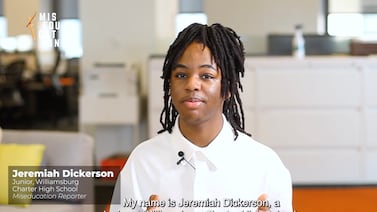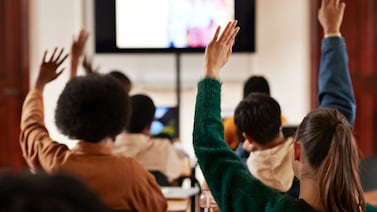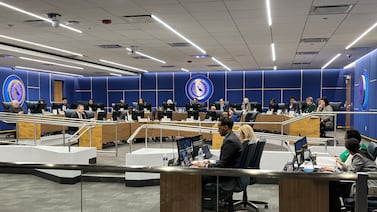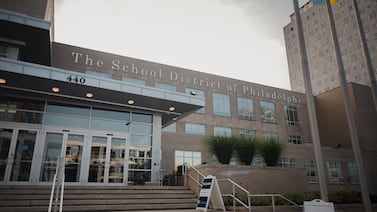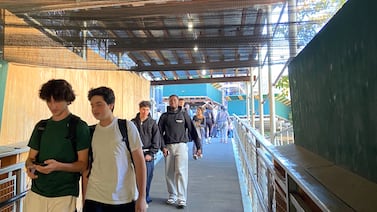Outside Chapel Hill 7th and 8th Grade Center, metal benches are arranged in clusters for an experiment in open-air learning. Inside, signs caution students and staff to wear face masks, keep 6 feet apart, and avoid drinking from the water fountain.
But the biggest change at the Indianapolis junior high school, which enrolls over 1,300 students and reopened last week, is that fewer than half the students are on campus each day.
Chapel Hill, in the west side district of Wayne Township, is using a hybrid model to teach during the coronavirus pandemic. Students come to campus two days a week and study from home the rest of the week, working on materials independently or meeting with teachers and classmates by video. About 300 students are signed up for fully online school.
To make hybrid instruction work, Chapel Hill had to invent a new approach. Educators must create lessons for the children in the building and those who are at home, and make the most of the time spent together in person.
Education leaders hope that with hybrid instruction and safety measures such as masks and outdoor classes, students will be able to get the benefits of attending in person while reducing the likelihood of transmitting the disease. At Chapel Hill, classrooms that once held over 30 students now have 15 or fewer, and there is more space for social distancing in the cafeteria and hallways.
“We missed our kids,” said Principal Kelin Mark. “For us to give them the opportunity as a district, where they can come in even for a couple of days, we think is going to help them socially, academically, personally.”
Last month, the Marion County Public Health Department issued guidance requiring most middle and high schools to use hybrid or remote instruction, citing the current coronavirus infection rates in the county. Elementary school students can attend in person full time. Some Indianapolis school districts, including Indianapolis Public Schools, have switched to entirely remote instruction. But most of the county’s districts are using a hybrid model like the one in Wayne.
Elsewhere, though, hybrid instruction may be the least popular plan for restarting schools, national research suggests. When the Center on Reinventing Public Education surveyed a nationally representative sample of districts in late July, about 12% were planning to reopen with a hybrid model. Almost 40% of districts planned to fully open in person, and 14% planned to reopen with remote learning. Information was not available for the others.
Hybrid reopening plans were more common in urban and suburban districts, where about 20% of districts were planning to use the approach. Because much of the country saw a surge in coronavirus infections over the summer and school district plans are in flux, the survey results could be outdated, said Betheny Gross, associate director of the CRPE.
The clear advantage of hybrid instruction is that “you at least get some face time with the kids,” Gross said. But hybrid schools still face some of the same challenges as entirely remote options. “The biggest question is figuring out how to keep kids productively engaged when they’re at home,” Gross said.
At Chapel Hill, students who enroll in the entirely virtual option log on for video lessons taught by Chapel Hill teachers during what are traditionally prep periods, said Dominic Day, the Wayne curriculum coordinator for secondary schools. Those teachers are paid for the extra work.
In the hybrid model, teachers don’t teach in-person and online students at the same time, Day said. Instead, teachers focus on working with students who are in the classroom, essentially spending two days a week teaching each cohort.
On days when students are at home, they are expected to work independently, following a daily schedule that includes practice work, tests, and recorded videos of the teachers, Day said. On Fridays, no students attend in person. Instead they spend some time working independently at home and some time meeting with teachers and classmates over video.
When students are at school, the district is encouraging teachers to focus on the kind of learning that is hard to do independently, Day said. It’s a good time, for example, for collaborative work, using the science lab, or tackling real-world applications of math skills.
“We know that it’s not a perfect situation,” Day said. But he said the district would try to make it equal to the quality of education before the pandemic “or even a better experience.”
Math teacher Sequoia Lee, who is new to Wayne Township this year, is optimistic that she will be able to keep students on track academically using the hybrid model.
“The location is different,” Lee said, because students are practicing skills at home. But teachers are always making decisions about what concepts are most important and where to devote their limited time. “These kids are smart,” she said. “They can blaze through some of these lessons.”
Lee is more worried about the social side of teaching during a pandemic. She used to be able to tell when children were having rough days and quickly check on them. Now, most days they will be at home, and if she connects by video, they might be uncomfortable opening up to a teacher with their family in the background. Even at school, the new health guidelines could constrain such interactions.
“It’s a relationship,” Lee said. “Just imagine being in a relationship and you can’t really show too much affection — whether it’s a high five, a hug, or a smile.”


